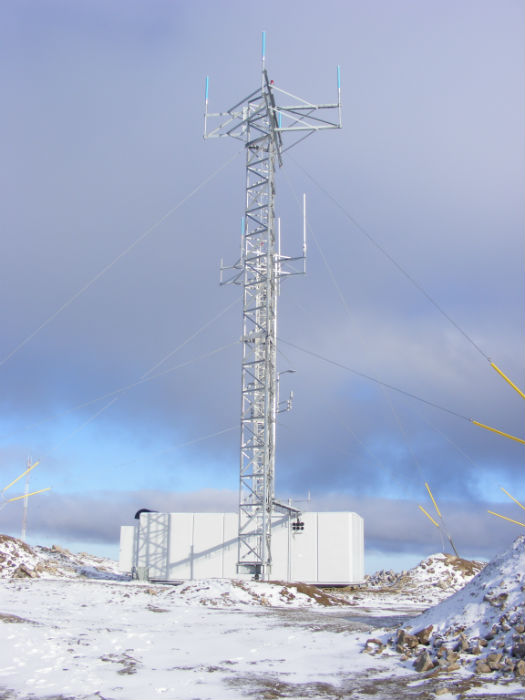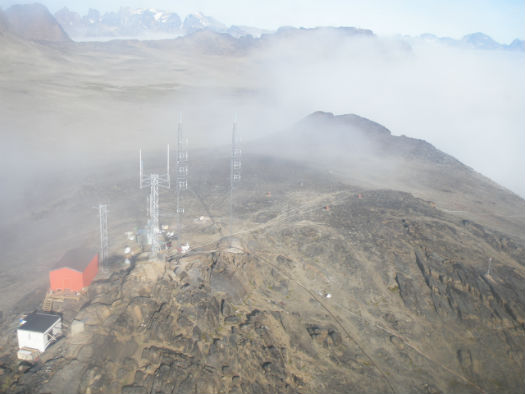An Iridium NEXT low-Earth orbit satellite.
THE BEGINNING
The first implementation of automatic dependent surveillance-broadcast (ADS-B) in Canada was in January 2009 in the airspace over Hudson Bay. With no existing radar, there had been a surveillance gap of 850,000 square kilometres. Nav Canada installed five ADS-B receiving stations on the ground at various locations around the shores of the Bay, to close that gap and provide coverage.
Canada’s air navigation services provider had decided to move to ADS-B back in 2007. Although the company had significantly expanded radar coverage in the north after taking over the air navigation system from the government, there was still a sizable amount of airspace with no radar surveillance.
In such airspace, because air traffic controllers only had voice position updates, they were required to use the procedural separation standard of 10 minutes, or approximately 80 nautical miles. ADS-B domestic surveillance now allows controllers to safely apply a five nautical mile separation for properly equipped aircraft; the same separation standard as radar.
Moving from procedural separation to surveillance separation gives air traffic controllers greater ability to offer equipped aircraft more flexible and cost-effective flight profiles, including earlier climbs to fuel-efficient altitudes.
The business case for implementing ADS-B rather than further radar expansion was solid. ADS-B could provide radar-like coverage at a fraction of the cost. ADS-B ground equipment costs much less to install and maintain than radar installations, and is also more durable in colder climates where much of the infrastructure would need to be located.
The airspace over Hudson Bay sees over 35,000 flights per year, primarily international traffic following routes connecting North America with Europe and Asia. As well, more aircraft are using cross-polar routes that transit through this airspace, and would benefit from the added surveillance.
This diagram explains how the Aireon global space-based ADS-B system functions.
EXPANSION
Beginning in November 2010, Nav Canada installed six more ground stations in the Eastern Arctic, which added 1.9 million square kilometres of ADS-B coverage in northeastern domestic airspace.
In March 2012, Nav Canada extended its surveillance to cover an additional 1.3 million square kilometres. This latest expansion was a new development as the additional airspace was over the North Atlantic. To expand the coverage to oceanic airspace, four ground stations were installed in southern Greenland.
The four installations in Greenland gave Nav Canada a total of 15 ADS-B ground stations providing close to 4.1 million square kilometres of surveillance. It is now possible for an intercontinental flight to go through approximately 3,300 kilometres of contiguous ADS-B coverage.
Because of the capability this new surveillance provided, the oceanic entry points were moved 185 nautical miles farther east over the North Atlantic in May 2014. This provides aircraft with an additional 20 to 25 minutes of flying time with the type of benefits they would have in domestic airspace, including higher, quicker and more direct routes for their flights. Separation standards for this portion of oceanic airspace have been reduced from 80 nautical miles down to 10.
BENEFITS
The economic and environmental benefits of expanding ADS-B surveillance are significant. It is estimated that air carriers will save over $370 million in fuel costs from 2009 to 2020. The accompanying greenhouse gas (GHG) emission savings for that period will total close to one million metric tons.
Adding ADS-B surveillance to over four million square kilometres of airspace—including 1.3 million square kilometres of oceanic airspace over the North Atlantic—has already reaped considerable fuel savings for air carriers and led to a reduction in GHG emissions.
But the benefits, especially considering the total size of the North Atlantic, represent an incremental improvement.
ADS-B is still limited by the need for ground-based receiving units and by a range of approximately 250 nautical miles, which means coverage over the oceans—which make up 71 per cent of the Earth’s surface—could not be served by the system. Further limitations exist in remote areas and mountainous areas where ground units are difficult and expensive to install.
Those limitations are about to disappear.
This ADS-B ground installation in Brevoort, Nunavut, is one of several that have allowed Nav Canada to expand its surveillance capabilities in northern domestic airspace.
NEXT: SPACE-BASED ADS-B
Nav Canada is a leading partner in a venture that will expand ADS-B coverage to the entire globe. Aireon LLC is a company that was initially established in 2012 as a joint venture between Nav Canada and Iridium Communications Inc., a leading satellite communications provider.
Aireon will achieve worldwide air traffic surveillance by installing ADS-B receivers on a constellation of 66 low-Earth orbit (LEO) satellites. The receivers will be part of the payload on Iridium NEXT, Iridium’s second generation constellation of LEO satellites.
The ADS-B receivers and satellites are being manufactured now. The first satellites are set to be launched in the summer of 2015; subsequent launches will continue in phases until mid-2017, when the satellite constellation will be complete.
Worldwide surveillance will be a game-changer for air traffic control. It is estimated that aircraft operators on the North Atlantic alone will save approximately $125 million per year in fuel costs with Aireon’s additional surveillance. This also translates to a reduction of GHG emissions of over 300,000 metric tons annually.
HOW WILL IT WORK?
Iridium NEXT will include a total of 81 advanced communications satellites consisting of 66 operational LEO satellites; six in-orbit spare satellites; and nine ground spares.
Iridium NEXT will replace the existing Iridium constellation of LEO satellites deploying the cross-linked architecture that provides continuous coverage over the entire Earth’s surface. Having 15 backup satellites helps ensure the system’s resiliency and redundancy, both in space and on the ground.
The satellite constellation operates in near-circular low-Earth orbit approximately 780 kilometres above the Earth’s surface. There are 11 satellites in each of six orbital planes, creating a cross-linked mesh network that provides coverage pole-to-pole. The low-flying satellites travel at approximately 27,000 kilometres per hour, completing an orbit of the Earth every 100 minutes.
An ADS-B ground installation at Fredriksdal, Greenland. The addition of four installations in Greenland allowed Nav Canada to expand coverage to oceanic airspace.
EQUIPAGE
A key advantage with Aireon is that the system will use the same ADS-B onboard equipage most commonly in use by airlines around the world. There is no costly retrofit to be done, which can impede the implementation of any new technology.
Many aircraft are already ADS-B equipped. Currently, over 90 per cent of the flights transiting the North Atlantic are flown by suitably equipped ADS-B aircraft. In the U.S., the Federal Aviation Administration (FAA) has issued a rule which requires all planes operating in airspace where a transponder is mandatory, to be ADS-B ready by 2020. Canada does not have any equipage mandate.
While the FAA has an ADS-B mandate, in some cases compliance with the U.S. rule would not mean compatibility with Aireon. The ADS-B system that Aireon will use—which is currently used by Nav Canada’s existing ADS-B—requires aircraft to be equipped with a 1090 MHz extended squitter (1090es).
The FAA mandates a 1090es only for aircraft flying above flight level 180 (approximately 18,000 feet). Aircraft flying below that altitude could be equipped with a universal access transceiver (UAT) 978 MHz. Planes equipped with a UAT 978 would not be visible to Aireon’s receivers, nor would they be visible within Nav Canada’s existing ground-based ADS-B airspace.
NEW PARTNERS
In late 2013, three additional air navigation service providers (ANSP) signed on as Aireon investors: ENAV (Italy); the Irish Aviation Authority; and Naviair (Denmark).
After a series of scheduled investments, ending in 2017, are converted to common equity, ENAV will hold 12.5 per cent of Aireon; the Irish Aviation Authority and Naviair will each hold six per cent; Nav Canada will be the majority owner with 51 per cent; while Iridium will retain 24.5 per cent of Aireon.
AIREON ALERT
The primary goal of Aireon is the improved efficiency and safety that worldwide surveillance will bring. However, with the tragic disappearance of flight MH370, the existing gaps in surveillance became a focus of attention and spurred an international urgency to look for solutions.
Aireon has announced its intention to provide accurate and real-time tracking data to authorized search and rescue operations in the event of a lost aircraft. To be known as Aireon Aircraft Locating and Emergency Response Tracking (Aireon ALERT) it will be offered as a global public service universally and on a no-fee basis.
ON TRACK FOR 2018
With the first satellites set to launch in the summer of 2015, much system testing has already taken place with positive results. In October 2014, the first ADS-B unit was delivered for integration into Iridium NEXT satellites. With the final launch in 2017, the service is expected to be operational in 2018.
Nav Canada, as the world’s second-largest ANSP, will be one of Aireon’s customers. Service agreements have been signed with U.K. air navigation services provider NATS; as well, partners in Italy, Ireland and Denmark will be customers.
Global pole-to-pole coverage will be a revolutionary change for air traffic management. Aireon’s satellite-based service is expected to increase safety and efficiency for all aircraft flying the skies.







